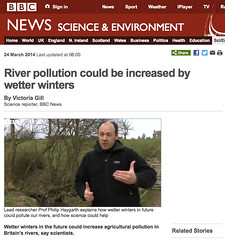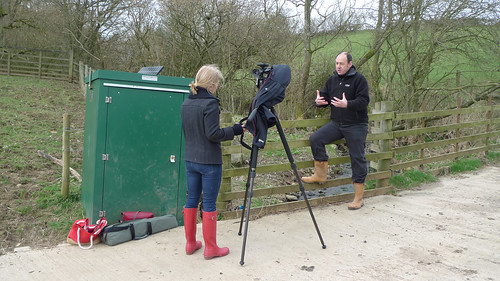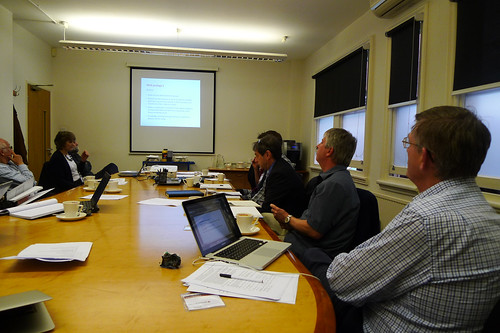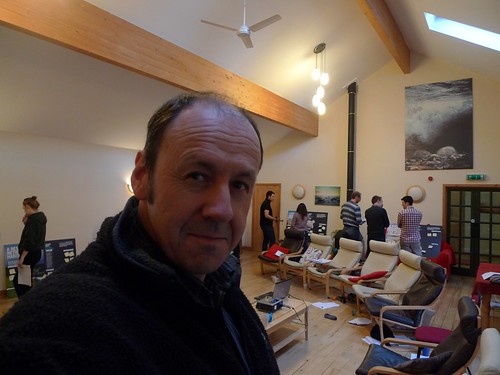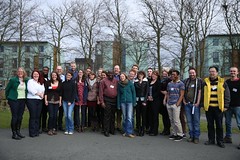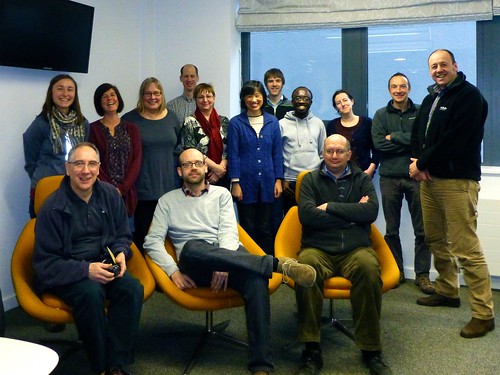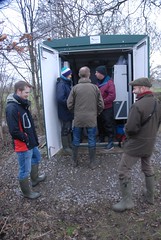Friday, 5 December 2014
#IYS2015 Inspiring the Next Generation to Celebrate #WorldSoilDay
Plant a tree, inspire the next generation.....
Today I have been proud to represent The British Society of Soil Science, where we have been out and about around Britain inspiring school children about soil. There is surely no better way to influence the future than to awaken young people about the value an importance of soils, as medium for plant growth, for providing clean water and air.
Many thanks to all my colleagues out and about around the Uk and indeed the World, who have helped celebrate World Soils day and launch the International Year of Soil.
My pictures from the day around Lancaster are here.
Tuesday, 2 December 2014
#IYS15 On the brink of the International Year of Soil!
I am very excited.
This Friday, 5th December kicks off the launch of the International Year of Soil (IYS) and as President of the British Society of Soil Science (BSSS), as well as a Professor of Soil and Water Science at Lancaster University, I am all of a buzz.
Soil is the often hidden resource that is essential for supporting everything we do in our lives, from providing the food we eat to purifying the water we drink and supporting the houses we live in. BSSS is planning a bumper set of activities, where thirty schools across the United Kingdom will be visited by a BSSS Soil Scientist for a tree planting this week. The society will also be marking the event in the Falkland Islands with a planting, and I will be doing a planting at Lancaster Girls Grammar School in Lancashire.
BSSS is looking to raise awareness of the importance of soils, celebrate our soils, catalyse initiatives and provide a modern perspective of soil science as well as marking the start of the road to the 2022 World Congress of Soil Science which BSSS will be hosting in Glasgow in August 2022.
To celebrate the start of the week here is a link to some recent soils films including a new one from Barry Rawlins on the importance of soils and the IYS. Please get the message out there, let's get it alive on the social media and spread the word with #IYS15
Thanks, Phil
This Friday, 5th December kicks off the launch of the International Year of Soil (IYS) and as President of the British Society of Soil Science (BSSS), as well as a Professor of Soil and Water Science at Lancaster University, I am all of a buzz.
Soil is the often hidden resource that is essential for supporting everything we do in our lives, from providing the food we eat to purifying the water we drink and supporting the houses we live in. BSSS is planning a bumper set of activities, where thirty schools across the United Kingdom will be visited by a BSSS Soil Scientist for a tree planting this week. The society will also be marking the event in the Falkland Islands with a planting, and I will be doing a planting at Lancaster Girls Grammar School in Lancashire.
BSSS is looking to raise awareness of the importance of soils, celebrate our soils, catalyse initiatives and provide a modern perspective of soil science as well as marking the start of the road to the 2022 World Congress of Soil Science which BSSS will be hosting in Glasgow in August 2022.
To celebrate the start of the week here is a link to some recent soils films including a new one from Barry Rawlins on the importance of soils and the IYS. Please get the message out there, let's get it alive on the social media and spread the word with #IYS15
Thanks, Phil
Saturday, 19 April 2014
On Floods and Farming……
With the terrible flooding that has been
experienced around the UK this last winter, I have just taken part in a panel debate on Radio 4’s Farming Today, aired on 19th April 2014, Easter Saturday. My role
was to provide a view about the ‘science’ of flooding and farming, what we know
and what we do not know. I hope the
following is a useful précis of the position…..
To
what extent does agriculture contribute to flooding events?
We know quite a lot about what happens in the
soil and even at the field or paddock scale, but as the scale increases so does
the uncertainty about what happens at the
catchment and basin scale – so the larger the catchment, the more uncertain is
the link between cause and effect. Local
flooding can be reasonably attributed to local agricultural sources, such as
the treading by animals or compaction arising from trafficking, all of which
affect the soil hydraulic conductivity, but larger than this there are other
things that come into play – topography, local geology, urban inputs etc..
To help the debate it is important to
consider the science of flooding. A
flood occurs because the rate input if water to the river channel exceeds the
capacity of the channel to hold the water, hence the catastrophic effects we
can often see when the rivers burst their banks. So, anything that can slow down the water
flow of the inputs is a good thing for flooding, anything that speeds it up is
not…...
About 60-70% of UK land is under
agriculture so clearly this is an opportunity for agriculture to play a
positive role in flood management (note also, conversely there are other
responsibilities too in non agricultural land 30-40% of the land area). Consider the analogy of a sponge. A sponge is good at holding water and that is
desirable and, by and large, is reasonable to say that soil can help act in
this manner – having pores spaces and a hydraulic conductivity that can help
slow down and store water. Conversely a concrete
car park is the opposite extreme as it has virtually no hydraulic conductivity
below the surface, and the speed of water flow away from a concrete car park to
he river channel is fast. This is very
undesirable, but on some occasions the same can happen to agricultural soil, as
soil becomes compacted, overland (fast flowing) runoff is increased and to
return to the original analogy, the sponge becomes destroyed.
At the soil
and field scale there has been lots of good research that supports this,
for example:
1.
There is a significant positive
relationship between saturated hydraulic conductivity and macroporosity. Conversely, trading by livestock has been
shown to reduce macroporosity.
Presence of animals, as opposed to forestry and trees, generally reduces
the hydraulic conductivity.
2.
Trafficking by farm vehicles
has a similar effect on soil storage.
3.
Some research has also shown an
affect of compaction in urban parks, due to foot, bicycle and urban traffic.
4.
Recent work has shown that
maize, plus other late sown crops, over wintering of livestock can all degrade
soil structure in SW England.
However, and this is so important in the
debate, at the catchment and basin scale
there is considerable uncertainty about linking the field scale affects to the
flood peak, as many contributing factors come into play. A great study published by Miles Marshall et
al in Hydrological Processes in 2009 focussed on the Pontbren Catchment in
Wales, a small tributary of the River Severn.
Here, they tried to overcome the issues of scale by studying plots as
well as the catchment up to 10 km2.
They say (I quote):
“there is little evidence to suggest that these
effects propagate downstream. This does not imply that these effects do not
exist, but rather that there has been little work to quantify this (O’Connell
et al ., 2007) and that the effects are difficult to distinguish from
catchment-scale data (Beven et al ., 2008).”
Miles Marshall et al in Hydrological
Processes, in 2009
So, in summary, there
is strong evidence at the field farm and plot scale, less so when we get to the
large scale – just because of the complexity of real catchments.
What solutions can farming offer?
There is no silver
bullet! However, I think that because
of the sheer land are where farming is so dominant (60-70%) then there are lots
of positive things that farmers can do. As
well as being food producers, farmers are inevitably custodians of the
landscape and my view is that nobody knows how to manage their land better than farmers do! So I start from the proviso that farmers know
best and they do not want to lose soil and water from their land. Back to the science
briefly, it is all about slowing down the runoff, increasing the soils
hydraulic conductivity – because water that is stored in the soils is better
than fast overland flow.
Things that can be done:
1.
Soil mechanical management, to
include use of tine to disrupt tramlines, topsoil lifting, sub-soiling, use of
tine (especially on tramlines) – all of these are mechanical things that a
farmer can do to improve structure and enhance pore space at depth.
2.
Landscape management, to
include hedgerows, berms, riparian areas, ponds. Ponds offer great potential, historically
there were many across the country, I am pleased to say numbers are now
increasing, we have about 500000 ponds in the UK today, and more can be
helpful. In the upland, blocking upland
drainage ditches can also be helpful, there is on-going work on Exmoor that is
demonstrating this from Richard Brazier.
3.
Animal management. In areas where the localised threat is
obvious, over wintering of livestock outdoors is to be avoided, and measures to
avoid the concentrating of livestock, for example around feed and drink
troughs, should be encouraged, by regular movement of the troughs.
4.
Tramline management. A single pass of a shallow tine has been
shown to have a positive effect from work by Martyn Silgram, spreading of straw
and vegetation of tramline is also helpful.
In extreme cases, , a gantry system may be helpful to avoid creating
tramlines.
5.
Naturalizing - in some cases the
use of trees can help, silvopasture systems are being talked about as having
benefits, and strategic use of trees, tree shelter belts around the
landscape.
6.
‘Hi Tech Plants’ – this is slightly
‘blue’ skies, but I
was recently involved in a project where soil scientist and plan scientists
collaborated to select grass plants with improved rooting properties that could
be used to better retain water – there may be some hi – tech biological
solutions out there.
7.
Partnerships, Tools, Strategic
Assistance can be a great way forward.
In the South West (cited in Palmer and Smith, December 2013) a great
initiative apparently hosted by The EA purchased and shared a subsoiler, and on
50% of the sites where it was used the soil structure was improved. Palmer and Smith also suggest a field
assessment tool for assessing soil structural stability – this has to be
useful. A great example is the National
Defra Demonstration Test Catchments as a way of bringing farmers, catchments
managers, residents, the EA, Rivers trusts and academics together to find a
common long-term solution. This has to
be the way ahead.
How
can we prioritise between the protecting of farmland and the protection of
homes?
This is difficult but we must try to do both. What is very obvious, local hydrological
connection between the farm and the flood, then we have to determine risk, and
roll out strategies (outlined in the above) to cope with this. If the risk is high and the hydrological
linkage is compelling, then more of the measures above need to be used. It is also about raising awareness and
communities to deal with the flooding together.
I was recently involved in a collaborative project called the NERC Virtual Observatory
where we tried to bring together farmers, agencies, and residents, to
understand the issues and potential solutions, together.
Is there choice between
flood defence and food security?
Absolutely not, I do not see that it is at al helpful to polarise
the debate here. Clearly there are
high-risk vulnerable flood areas that we need to take a close look at, but the
most sensible solution is remembers that soil and farms are by and large well suited
to retaining water, so if we can find an integrated solution with food
production and reduced flooding, this has to be the way ahead. We need to value and respect farmers as
custodians of the landscape and help them, in partnerships with agencies and
academics, use tools to assess risk and to find solutions together.
P. M. Haygarth, Lancaster University, 16th April 2014
Monday, 24 March 2014
BBC Web Story - Farming and River Pollution
Today Vic Gill from BBC Science released the story that she filmed with me last week in the Eden, introducing the new project where we hope to study potential climate change and land use and how it may affect farming and water quality. Here is the link to the story and the film and it maybe interesting to also view the recent training film I made on the issues for context. I also did an early morning gig on Farming Today (Radio 4) and local Radio Lancashire and Cumbria.
Thursday, 20 March 2014
Filming for BBC Breakfast TV
This morning I met Vic Gill from BBC Science to do a piece on the NUTCAT 2050 project - studying land and water quality and how this may change in the future with changes in climate and land use. It was as a fun filming experience, supported by fellow NUTCAT team members Michael and Mary. Thanks all.
Film of the BSSS 2013 Annual Conference
Just look at all the fun you are missing of you are not a member of the British Society of Soil Science!
Wednesday, 19 March 2014
'NUTCAT' Steering Group - Thank-you!
Yesterday the NUTCAT 2050 team met in Birmingham with our steering group - the first of the annual steering meeting and had a terrific session with our invited distinguished 'steerers', with lots positive feedback and reinforcing advice. Thank-you!
Monday, 17 March 2014
Selfie - Soil-Water Training - in the Eden!
It has been another great day of training PhD students, this time today I joined Ben Surridge's course in the beautiful Eden Valley and at the equally as impressive Habergill Centre. It was a beautiful dusk drive through the Eden and into the Lune. Here is a selfie just before the lecture and - some additonal photos here.
Wednesday, 12 March 2014
A busy and fulfilling week- #Soilunderfoot
Last week was a terrific experience.
In collaboration with my colleagues John Quinton (from Lancaster University LEC), Kathryn Alton (from the British Society of Soil Science BSSS) and Helaina Black from the JHI in Aberdeen, we ran a week long NERC funded doctoral training course for soil PhD students focussing on PG level soils. I was PI and the run up to the course had been quite time consuming and had posed a few worries and headaches, but supported by the great team it all came together very well - thanks to all the inner team and to the additional contributing lecturers (David Powlson, Jac Hannam, Dick Thompson, Willie Towers, Sacha Mooney, Wilfred Otten, Matt Aitkenhead, Andrew Binley).
We had 24 students and what was so exciting was that we were using some funky techniques for the lectures and teaching. Both John and I have made some training films (with Dependable Productions, a terrific company led by my long term friend Richard Critchlow, so good to work with) on soil-water transfers and soil-security and we have asked the students to work with us to make two more after the course. Additionally, we also ran some live lectures by the team, and some of these are still available as a legacy from John on Soil Security, Helaina on Soil Biology (can be viewed here and by myself on soil water transfers. Throughout the cpousre we were running questions and live interatiosn on twitter (#soilunderfoot)
We also tried some working group activities where we asked teams of students to consider a high level soil science question which had to be presented back to the group in 'The Apprentice' style on the final morning. It proved highly successful and was also a lot of fun. Congratulations to 'Team Kathryn' for winning he student vote for the best proposal!
We had some terrific some feedback from the students.
"I wanted to say thank you to you all for a fantastic week at Soil Underfoot. I have learnt so much and look forward to going through all the material you very kindly put up on moodle for us. It was a great opportunity to meet other people in the same sector and get to know more about the current research that is happening all over the county and beyond, also to hear what your visions of the future are.
I do hope that you are able to run course like this in the future so others can gain from the experience (even the late nights). I got a lot out of the group challenge just getting in to that mind-set was a challenge. I thought there was a nice balance of field work with lectures and practical sessions."
Karen Walmsley, Harper Adams
and how about this news just in....
I am pleased to inform you that I defended successfully today my PhD thesis titled ''Mobility and Bioavailability of Arsenic in Ochre Amended Soils''.Thank you for organising the NERC Doctoral training course, 'Understanding the soil underfoot'. It helped me in the preparation for my viva.
Joseph Olimah, University of Reading
Feedback doesn't get better than that!
In collaboration with my colleagues John Quinton (from Lancaster University LEC), Kathryn Alton (from the British Society of Soil Science BSSS) and Helaina Black from the JHI in Aberdeen, we ran a week long NERC funded doctoral training course for soil PhD students focussing on PG level soils. I was PI and the run up to the course had been quite time consuming and had posed a few worries and headaches, but supported by the great team it all came together very well - thanks to all the inner team and to the additional contributing lecturers (David Powlson, Jac Hannam, Dick Thompson, Willie Towers, Sacha Mooney, Wilfred Otten, Matt Aitkenhead, Andrew Binley).
We had 24 students and what was so exciting was that we were using some funky techniques for the lectures and teaching. Both John and I have made some training films (with Dependable Productions, a terrific company led by my long term friend Richard Critchlow, so good to work with) on soil-water transfers and soil-security and we have asked the students to work with us to make two more after the course. Additionally, we also ran some live lectures by the team, and some of these are still available as a legacy from John on Soil Security, Helaina on Soil Biology (can be viewed here and by myself on soil water transfers. Throughout the cpousre we were running questions and live interatiosn on twitter (#soilunderfoot)
We also tried some working group activities where we asked teams of students to consider a high level soil science question which had to be presented back to the group in 'The Apprentice' style on the final morning. It proved highly successful and was also a lot of fun. Congratulations to 'Team Kathryn' for winning he student vote for the best proposal!
We had some terrific some feedback from the students.
"I wanted to say thank you to you all for a fantastic week at Soil Underfoot. I have learnt so much and look forward to going through all the material you very kindly put up on moodle for us. It was a great opportunity to meet other people in the same sector and get to know more about the current research that is happening all over the county and beyond, also to hear what your visions of the future are.
I do hope that you are able to run course like this in the future so others can gain from the experience (even the late nights). I got a lot out of the group challenge just getting in to that mind-set was a challenge. I thought there was a nice balance of field work with lectures and practical sessions."
Karen Walmsley, Harper Adams
and how about this news just in....
I am pleased to inform you that I defended successfully today my PhD thesis titled ''Mobility and Bioavailability of Arsenic in Ochre Amended Soils''.Thank you for organising the NERC Doctoral training course, 'Understanding the soil underfoot'. It helped me in the preparation for my viva.
Joseph Olimah, University of Reading
All worry was worth it! Congratulations and thanks to all, some photos from the final day taken by Dependable Productions are here.
Phil Haygarth
Lancaster, 12th March 2014
Saturday, 1 March 2014
Movie: An introduction to Soil-Water Transfer
I am excited to have just completed this movie as part of a NERC
Doctoral Training, in collaboration with the British Society
of Soil Science and The James Hutton Institute. The Film Team were Dependable Productions. Thanks to the EdenDTC and the Eden community
for assistance in the making of this film. Please use and share! Phil
Doctoral Training, in collaboration with the British Society
of Soil Science and The James Hutton Institute. The Film Team were Dependable Productions. Thanks to the EdenDTC and the Eden community
for assistance in the making of this film. Please use and share! Phil
Saturday, 15 February 2014
A great new BBSRC Phosphorus Team!
This week I was privileged to host a brand new team meeting at Lancaster to tee off the new BBSRC project on better utilization of soil organic P. It was a first coming together with staff contributing from Africa, China, Brazil, Scotland, England and the USA! It's going to be a good one folks! Here are a few photos of the gathering. A video will follow!
Tuesday, 11 February 2014
Sharing experiences on catchment change
We recently ran a workshop in the River Eden valley, at the Crown Inn in Morland to share catchment, climate and land use change experiences, in living memory. The meeting was introduced by guest speaker Dr Peter Falloon from the Met Office Hadley Centre in Exeter, who set an interesting tone presenting the data and uncertainties in weather and climate patterns in the Eden over recent years. It was enthusiastically attended by farmers from the Lune and Eden Valley, as well as academics and other stakeholders. One observation by one of the more experienced farmers was a note that the big changes he had witnessed over his lifetime were (1) mechanisation and (2) the influence of genetic innovation, particularly for dairy animals. A few snaps from the evening - including a dinner of stew and chips and a couple of pints - are here.
Team 'NUTCAT' visit EdenDTC
Recently a number of us from the new NERC 'NUTCAT' funded project had a tour of the EdenDTC, with a particular focus on Morland. The NUTCAT Project is concerned with 'helping to understand and improve water quality in our rivers - present and future' and you can learn more about the project here and view a few of the wet and wintery scenes here.
Friday, 7 February 2014
LEC's RGS Ambassadors
Here is a 'selfie' taken last week with the impressively bearded Simon Faulkner from the Royal Geographical Society, together with Lancaster Environment Centre's stalwart Geography Ambassador, Dan Flanagan. Dan, trained by Simon, has been out and about in the schools around the country spreading the word about Geography. Last week Simon, aided by Dan, trained another enthusiastic bunch of LEC ambassadors and the cycle starts again. Nice job everybody!
Tuesday, 14 January 2014
Recruiting - Phosphorus PhD project at Lancaster University and Rothamsted
We have an exciting PhD studentship oportunity and we are seeking high quality applicants.
This fully funded PhD studentship is part of the NERC ENVISION Doctoral Training Programme and is an excellent opportunity to work on the development of novel measures for tracing phosphorus
This project will use a novel stable isotope technique to better understand phosphorus (P) cycling within the plant-soil-water system. By advancing fundamental understanding of P biogeochemistry, the project seeks to address challenges related to plant nutrition and agricultural production, alongside the protection of water quality. The supervisory team offers access to knowledge and facilities related to phosphate oxygen isotope research across the UK and Europe.
The key objectives of this studentship will be to:
1) Understand the partitioning of newly-applied P between individual soil P pools;
2) Understand the bioavailability of P within individual soil P pools, and the mechanisms through which P in these pools is accessed by organisms;
3) Understand the mobility of soil and plant P fractions within soil water and the risk of export of P in runoff or leachate from the plant-soil system.
For Full details please see The Envision Site
best wishes
Phil
This fully funded PhD studentship is part of the NERC ENVISION Doctoral Training Programme and is an excellent opportunity to work on the development of novel measures for tracing phosphorus
This project will use a novel stable isotope technique to better understand phosphorus (P) cycling within the plant-soil-water system. By advancing fundamental understanding of P biogeochemistry, the project seeks to address challenges related to plant nutrition and agricultural production, alongside the protection of water quality. The supervisory team offers access to knowledge and facilities related to phosphate oxygen isotope research across the UK and Europe.
The key objectives of this studentship will be to:
1) Understand the partitioning of newly-applied P between individual soil P pools;
2) Understand the bioavailability of P within individual soil P pools, and the mechanisms through which P in these pools is accessed by organisms;
3) Understand the mobility of soil and plant P fractions within soil water and the risk of export of P in runoff or leachate from the plant-soil system.
For Full details please see The Envision Site
best wishes
Phil
Subscribe to:
Comments (Atom)
